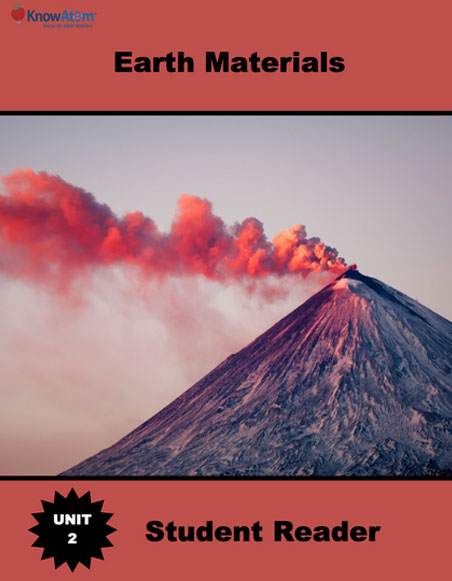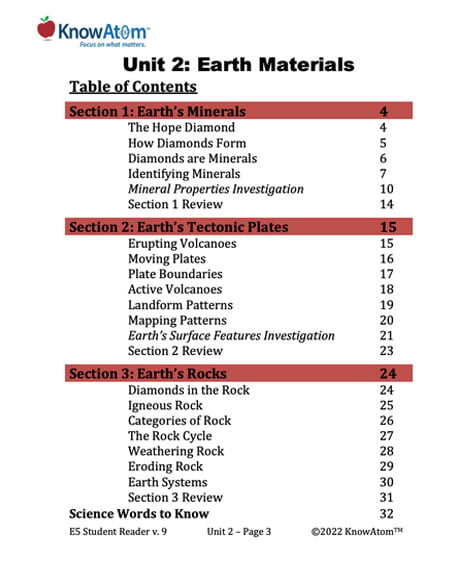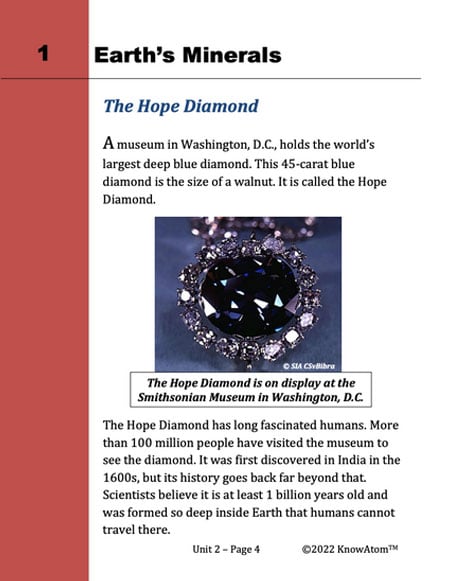In this lesson, students analyze the kinds of atoms that make up different substances and figure out the way those atoms combine to determine the phenomena exhibited in the substance’s properties.
In this unit, students study the processes that shape Earth’s surface, focusing on the formation of minerals (such as diamonds) and rocks. In this lesson, they explore the phenomena exhibited in the properties of rocks and minerals to figure out how the properties of different minerals are a tool to identify them. This page is a high-level overview of this lesson.
Science background provides teachers with more detailed information about the phenomena students explore in this unit. Here is an excerpt from the science background information on Earth materials.
All diamonds have the properties they do because of their atomic makeup and structure. Diamonds are minerals, which means they are naturally occurring, inorganic solids with a crystal structure.
Carbon atoms in diamonds form extremely strong bonds in the shape of a three-sided pyramid, called a tetrahedron. This creates a rigid lattice that doesn’t allow the atoms to move. This structure causes diamonds to be extremely hard. Hardness is a measure of a mineral’s resistance to scratches. Mineralogists use a 1-10 hardness scale called the Mohs scale. Talc is a 1, which means it is very soft. Diamond, in contrast, is a 10, making it the hardest naturally occurring mineral. It is so hard that only another diamond can scratch it.
The hardness of diamonds makes them useful for many different applications because they can be used to cut other materials including stone, metal, and concrete. For example, they are used in cutting tools for military materials such as airplane parts and armor.
Diamonds’ atomic structure also causes them to have a high melting point. Diamonds are also excellent thermal conductors, which means they conduct heat.
Scientists rarely rely on just one property test when they are identifying different minerals. Many minerals share the same physical properties, including color and hardness. However, when many of a mineral's properties are examined, it often results in a unique set of properties that can be used to correctly identify the mineral.
For example, in addition to hardness and conductivity, diamonds also often have a high luster. Luster is the way light reflects off of the surface of a mineral, and how bright, dull, or greasy the mineral appears. Luster falls into two categories: metallic and nonmetallic. Cut diamonds often have a metallic luster. This gives them a brilliant, freshly polished look. In contrast, uncut diamonds can have a greasy or dull luster.
Pure diamonds are also the most transparent known material. Transparent substances allow light to pass through. Pure diamonds are rare, however. Some non-pure diamonds are translucent, which means they allow some light through and absorb some light. Opaque diamonds absorb all light.
All diamonds are formed deep within Earth, at least 161 kilometers (100 miles) below the surface. They can only form under tremendous heat and pressure deep within Earth’s structure. At temperatures reaching 1,200 degrees Celsius (2,192 degrees Fahrenheit) and under deep pressure, carbon atoms come together within Earth’s interior to link in a crystal structure to form diamonds. Earth’s interior is powered by heat that originates in Earth’s center, called the inner core. The inner core is a solid ball of metal iron and nickel that reaches 7,000 degrees Celsius, hotter than the surface of the sun.
The inner core is surrounded by the outer core, which wraps around the inner core and is made of liquid iron and nickel. This metal gives Earth a magnetic field, which shields the planet from the sun’s radiation.
The mantle is located around the outer core and is mostly molten, semi-solid rock called magma. The mantle makes up almost two thirds of the Earth's mass and is about 2,900 km (1,802 miles) thick. It is here where diamonds are formed. Earth’s crust is the hard rock layer of the planet that supports the continents and oceans.
In this lesson, students analyze the kinds of atoms that make up different substances and figure out the way those atoms combine to determine the phenomena exhibited in the substance’s properties.

Prepared hands-on materials, full year grade-specific curriculum, and personalized live professional development designed to support mastery of current state science standards.
Mineral : a naturally occurring, inorganic solid with a crystal structure
Rocks : mixed mineral matter that makes up the surface of Earth and other terrestrial objects
System : a set of connected, interacting parts that form a more complex whole
The Hope Diamond
A museum in Washington, D.C., holds the world’s largest deep blue diamond. This 45-carat blue diamond is the size of a walnut. It is called the Hope Diamond.
The Hope Diamond has long fascinated humans. More than 100 million people have visited the museum to see the diamond. It was first discovered in India in the 1600s, but its history goes back far beyond that. Scientists believe it is at least 1 billion years old and was formed so deep inside Earth that humans cannot travel there.


How Diamonds Form
All diamonds are formed deep within Earth, at least 161 kilometers (100 miles) below the surface. They can only form under tremendous heat and pressure. This heat and pressure are a result of Earth’s structure.
The center of Earth is a solid ball of metal iron and nickel. It is called the inner core. The core is 7,000 degrees Celsius, hotter than the surface of the sun. The outer core wraps around the inner core and is made of liquid iron and nickel.
The mantle is located around the outer core. The mantle is Earth’s thickest layer. Imagine an apple. The core of the apple is like Earth’s core, and the fleshy part that you eat is like the mantle. Earth’s mantle is an ocean of semi-solid rock called magma. It is here where diamonds are formed.
Earth’s “skin” is its crust. The solid crust is the coolest layer of the planet that forms the continents and holds the oceans.
Diamonds Are Minerals
Diamonds are made mostly of a single element—carbon. The heat and pressure of Earth’s interior caused the carbon atoms to join together in a way that resulted in the unique physical properties of diamonds.
Diamonds are minerals. Scientists have found more than 3,000 minerals, made up of different combinations of elements.
All minerals are naturally occurring, which means they are not made by humans. They would exist on Earth without people. Minerals are also inorganic because they are not the product of something that is living or was once alive. (Leaves and shells are organic because they come from something that was once alive.)
They also have a definite chemical composition. This means that every mineral is made up of the same kind and number of atoms. For example, diamond can always be described by the chemical formula of C since it is made of carbon atoms. Lastly, minerals have an orderly crystal structure. This means their atoms are neatly organized to form a repeating pattern.

Identifying Minerals
One of the reasons that people are drawn to the Hope Diamond is its color. Blue diamonds are very rare. They are blue because they have traces of the element boron combined with the carbon atoms. Diamonds come in many different colors, including red, yellow, green, purple, and brown. Color is one property that scientists use to identify minerals.
In addition to color, there are many other property tests that scientists can do to identify a mineral. For example, scientists were fascinated to discover that the Hope Diamond gives off a fiery red glow after it has been exposed to ultraviolet (UV) light. This is called phosphorescence. Scientists have learned that all natural blue diamonds glow red for about five minutes after being exposed to UV light. However, blue diamonds created by humans give off different colors. Because of this, phosphorescence helps scientists determine whether a blue diamond is real or fake. Other diamonds do not phosphoresce. Instead, they fluoresce, which means they give off light only as long as UV light is shined on them.
In this lesson, students figure out the composition of rocks and minerals by experimenting on the physical phenomena exhibited by different samples to determine if the physical properties of a sample can be used to identify it. Then, they use the data from their investigation to figure out why scientists use multiple properties to identify minerals. Students use their knowledge of atoms, elements, and minerals, to evaluate why different rocks and minerals have unique sets of properties.
KnowAtom incorporates formative and summative assessments designed to make students thinking visible for deeper student-centered learning.

Standards citation: NGSS Lead States. 2013. Next Generation Science Standards: For States, By States. Washington, DC: The National Academies Press. Neither WestEd nor the lead states and partners that developed the Next Generation Science Standards were involved in the production of this product, and do not endorse it.